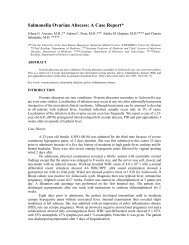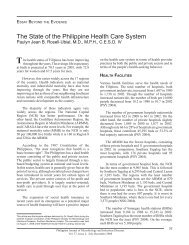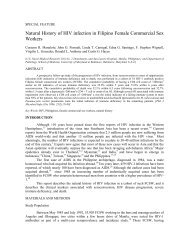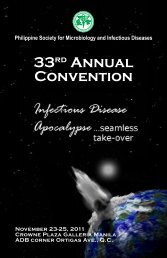The Philippine Clinical Practice Guideline on the Diagnosis and ...
The Philippine Clinical Practice Guideline on the Diagnosis and ...
The Philippine Clinical Practice Guideline on the Diagnosis and ...
Create successful ePaper yourself
Turn your PDF publications into a flip-book with our unique Google optimized e-Paper software.
3.3 Route of administrati<strong>on</strong>. Patients with mild to moderate symptoms can he treated with oral<br />
antimicrobials for <strong>the</strong> total durati<strong>on</strong> of treatment (Grade B). Parenteral <strong>the</strong>rapy is recommended<br />
for initial management of patients who may have severe infecti<strong>on</strong> (presence of chills, fever,<br />
vomiting with or without shock) <strong>and</strong> for patients with nausea, vomiting or ileus (Grade C).<br />
Switching to an oral regimen is appropriate <strong>on</strong>ce <strong>the</strong> patient is a febrile for at least 24 hours <strong>and</strong> is<br />
able to take <strong>the</strong> drug orally (Grade C).<br />
3.4 Durati<strong>on</strong> of <str<strong>on</strong>g>The</str<strong>on</strong>g>rapy. <str<strong>on</strong>g>The</str<strong>on</strong>g> recommended durati<strong>on</strong> of <strong>the</strong>rapy for AUPN is 14 days for most<br />
antimicrobials, except for ciprofloxacin for which 7 days is sufficient (Grade A). Treatment for<br />
l<strong>on</strong>ger than 14 days has no added benefit <strong>and</strong> is not recommended (Grade E).<br />
Table 3. Treatment regimens for uncomplicated acute pyel<strong>on</strong>ephritis<br />
Characteristic Pathogens <str<strong>on</strong>g>Clinical</str<strong>on</strong>g> Situati<strong>on</strong> Recommended Empiric Treatment<br />
E. coli,<br />
P. mirabilis,<br />
K. pneum<strong>on</strong>iae,<br />
S. saprophyticus<br />
Mild-to-moderate illness,<br />
no nausea or vomiting,<br />
- outpatient <strong>the</strong>rapy<br />
Severe illness or<br />
possible urosepsis<br />
- hospitalizati<strong>on</strong> required<br />
Oral*<br />
fluoroquinol<strong>on</strong>e, TMP/SMX or co-amoxiclav for 14 days<br />
Parentereral**<br />
aminoglycoside, fluoroquinol<strong>on</strong>e or third generati<strong>on</strong><br />
cephalosporin until fever is g<strong>on</strong>e (usually after 24-48 hrs),<br />
<strong>the</strong>n<br />
oral fluoroquinol<strong>on</strong>es or TMP/SMX to complete 14 days<br />
*Oral regimens: ciprofloxacin 500 mg every 12 hours; ofloxacin 200 mg every 12 hours; norfloxacin 400 mg<br />
every 12 hours; lomefloxacin 400 mg <strong>on</strong>ce a day; TMP/SMX 160/800 mg every 12 hours; co-amoxiclav 625 mg.<br />
every 8 hours. Ciprofloxacin may be given for seven days (see Secti<strong>on</strong> 3.4).<br />
**Parenteral regimens: ceftriax<strong>on</strong>e 1-2 g <strong>on</strong>ce a day; ciprofloxacin 200-400mg every 12 hours; ofloxacin 200-400<br />
mg every 12 hours; gentamicin 3-5 mg/kg <strong>on</strong>ce a day or 1 mg/kg every 8 hours.<br />
4. Work-up for urologic abnormalities<br />
Routine urologic evaluati<strong>on</strong> <strong>and</strong> routine use of imaging procedures are not recommended<br />
(Grade D). Radiologic evaluati<strong>on</strong> should he c<strong>on</strong>sidered if <strong>the</strong> patient remains febrile within 72<br />
hours of treatment to rule out <strong>the</strong> presence of nephrolithiasis, renal or perirenal abscesses, or o<strong>the</strong>r<br />
complicati<strong>on</strong>s of pyel<strong>on</strong>ephritis, or if <strong>the</strong>re is recurrence of symptoms (Grade C). Urologic<br />
c<strong>on</strong>sultati<strong>on</strong> should be obtained if deemed appropriate (Grade C).<br />
5. Follow-up cultures during <strong>and</strong> post-<strong>the</strong>rapy<br />
In patients who are clinically resp<strong>on</strong>ding to <strong>the</strong>rapy (usually apparent in < 72 hours after<br />
initiati<strong>on</strong> of treatment), <strong>the</strong>re is no need for a follow-up urine culture (Grade C). Routine posttreatment<br />
cultures in asymptomatic patients are also not indicated except in patients who initially<br />
present with sepsis (Grade C). In women whose symptoms do not improve during <strong>the</strong>rapy <strong>and</strong> in<br />
those whose symptoms recur after treatment, a repeat urine culture <strong>and</strong> sensitivity test should be<br />
performed (Grade C).<br />
6. Re-treatment<br />
Recurrence of symptoms requires antibiotic treatment based <strong>on</strong> results of urine culture <strong>and</strong><br />
sensitivity test, in additi<strong>on</strong> to assessment for underlying genito-urologic abnormality (Grade C).<br />
<str<strong>on</strong>g>The</str<strong>on</strong>g> durati<strong>on</strong> of re-treatment in <strong>the</strong> absence of a urologic abnormality is 2 weeks (Grade C). For<br />
those patients who relapse with <strong>the</strong> same strain as <strong>the</strong> initially infecting strain, a 4-6 week<br />
regimen is recommended (Grade C).







